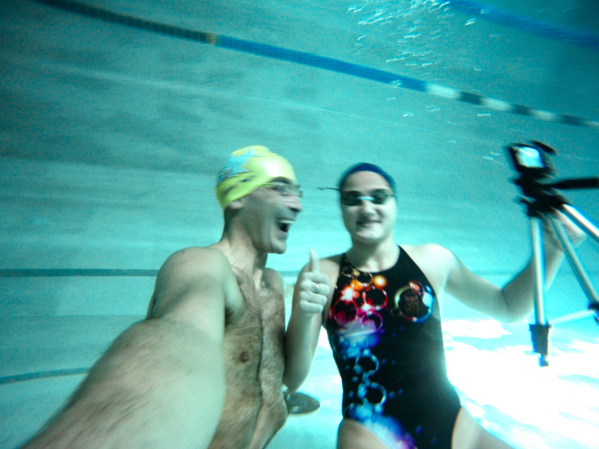Nothing fuels our squad goals like a lean, mean swim team. And for an underwater photographer who wants to shoot authentic portraits of swimmers, nothing beats capturing all the action in a pool. Not only is it a more controlled environment (versus a tempestuous ocean) — pools also tend to shimmer with crystal-blue water that works with indoor or natural light to create shapes, texture, and many other elements. All these can instantly turn up the drama in any photo.
One photographer making a splash with swimming pool portraits is Giuseppe Tiravanti. His lyrical work involving graceful and strong swimmers has been exhibited at the Polo Natatorio Foro Italico, a historical pool in Rome that alo serves as the headquarters of the Italian Swimming Federation.
By day, he is a project manager and IT specialist in Rome. When we asked him how he came to photography, we learned that this athlete has been an Italian Masters swimmer since 2007. But in 2013, a cycling road accident on his way to a swim training session made it impossible for him to join the racing season. “I longed for the water, so I decided to grab a camera, and started taking pictures of my fellow swimmers and friends during their workout,” Giuseppe shares. “At the beginning, I was doing this without formality. But as time went on, I formed a purpose. I began collecting an archive of images. Over time, this collection has grown to include photographs of athletes training for swimming, synchronized swimming, and lifesaving swimming.”
Read on as Giuseppe shares his best photo tips and tricks for capturing soulful portraits of strong swimmers!
1. Know your camera. Shooting underwater sport scenes in indoor pools means getting acquainted with fast shutter speeds and (inevitably) high ISOs, often well into the thousands. Before getting underwater, test your camera for the quality of pictures you feel is acceptable, and find your ISO/shutter speed match while on dry ground. If you do your homework, you’ll find yourself shooting in full manual mode, except for autofocus. If you are shooting with an automatic program on your DSLR, think back and ask yourself if you are familiar enough with your camera. Automatic programs will spoil your shoot by changing your settings (ISO, aperture, speed) when you least want them to do it. I prefer to shoot RAW, but I do fall back on JPG when tracking fast and long scenes.
2. Be comfortable. I got into underwater photography because, first and foremost, I’m a swimmer. I’m comfortable being in the water. I manage well to dive without scuba diving gear. I prefer the freedom to be able to track my subjects closely with fins and being unencumbered by wetsuits or gas canisters. You may prefer otherwise, so whatever you choose, pay close attention to feeling at ease with your underwater gear. You should be able to concentrate only on shooting. Make sure your goggles and masks don’t easily fog, or that your wet suit and gear isn’t too bulky or have the wrong buoyancy.
3. Mind your pool cred. Even though swimmers are a wonderful bunch of people, you will still need the trust and respect of your subjects and models. Standard recommendations apply, such as making an effort to getting to know your models. Show them your portfolio before entering into the pool with them. No matter your speed or strength, it will be more impactful if they feel you belong in the place and if you can show them that you can match their speed. Fins can definitely help here. Try not to look like a black bobbing mass of neoprene. Show them you are one of them.
4. Go to pool training sessions. Take advantage of these sessions. They’re a unique occasion for ideal underwater photo shoots to take place. Only a few photographers take advantage of them, and they happen to also be swimmers themselves. Your subjects and models might be shy or excited, so the key person in this siutation is the coach. Make sure your coach understands and approves all you want to do for your shoot. Your swimmers will most likely do what their coach tells them to do, and generally not what YOU tell them to do.
5. Make a checklist of your gear. There are never enough SD cards, spare batteries, extra underwater lighting, and dry towels at hand. Make sure you have plenty of those. Label, label, label everything, and stick to pre-determined procedures. This will save your sanity, and spare you from mayhems particularly when shooting in the thick of race sessions.
In case you’re curious, my own gear consists of my underwater camera, which is a Sony A6000 with Sigma 19mm F2.8 glass in a Meikon underwater case. I also use a Nikon AW120 and a GoPro Hero3 Silver. In my camera bag, you’ll always find a spare pair of clear plastic goggles, abundant empty SD cards (I’m set on 64GB size), spare batteries, dry towels, at least a couple of cheap metal tripods you can use underwater, fins, a weight belt, and a couple of scuba diving underwater lights. For shots on dry ground, I use a Nikon D5200 with a full range of lenses from 12mmm to 300mm.

Giuseppe Tiravanti with one of his favorite swimmer models, Giulia Lazzari.
6. Make your subjects and models feel at ease. Get hold of a rugged compact camera and hand it over to your swimmer models to play with it themselves. (In my case, I have a Nikon AW120 (the GoPro is not ideal, you need the backscreen on the camera.) This will give them an entirely new perspective on the challenges you face when shooting underwater. If you’re lucky, they can give you valuable first-hand feedback and suggestions on the kind of themes and scenes that might interest them. You need their input. Even the most accomplished swimmer-turned-photographer cannot keep up with every technique or specialty in the field of swimming.
7. Prepare for the shoot ahead of time. Think about these important questions before every shoot: What are you interested in capturing? Close shots? Documenting specific technical skills? Group shots? Full body figures? Head shots? Form a rough idea of what you seek to achieve. Then, discuss it with the coach to make sure it is feasible within the boundaries and circumstances of the training session. When you’re in the water, don’t get in the way of the swimmers, and maintain your position within agreed boundaries.
8. Be flexible and always be prepared for change. When shooting underwater, there’s so much beyond the photographer’s control that can change your process, including lighting, quality (turbidity, optical transparency) of water, maximum depth, whether the pool is crowded or empty. For example, it’s futile to attempt shooting group shots from a distance if you find yourself in a poorly-lit pool with opaque water. In this case, you’re better off focusing on getting close-ups. With practice, you’ll learn to adjust your plans to fit the current environmental conditions.
9. Never rely on a single take. There are plenty of factors that can spoil your pictures, including water bubbles getting in the way of the depicted subject. Always attempt to shoot several takes of a scene and situation.
10. Jump in! It’s fun, and it’s easier than you think! As you’ve read, most of it is down to experience really. So, come on have a crack at it — you’ll get better at underwater photography soon.
11. Post-processing tip. I post-process most of my shots with Photoshop. Other than helping you adjust the composition and framing, I find Photoshop most valuable for correcting lens distortion, and bringing your pics back to a color range/tone more pleasing and natural than the subdued weird-greenish-tinted pics that too often come straight out of the camera sensor. Personally, I prefer color pics to B&W as I find that in this way you have way more opportunities for artistic expression. With color, however, you’ll have to develop your own taste and sensibility, according to what you aim to achieve with your pics. Once again, it’s mostly a matter of experience — just start experimenting, which brings me to my last tip…
12. Never stop experimenting and attempting to do new things. Don’t worry if the quality of your early shots is not up to the standard you seek. Your first 10 thousand photographs are your worst.
To see more of his dreamy and incredible work, follow Giuseppe Tiravanti on 500px. You can also check out and support The Joy of Swimming, a non-profit project he founded that aims to spread the love and passion for swimming sports and for the safe enjoyment of water.



























Leave a reply